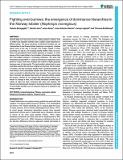Por favor, use este identificador para citar o enlazar a este item:
http://hdl.handle.net/10261/161737COMPARTIR / EXPORTAR:
 SHARE SHARE
 CORE
BASE CORE
BASE
|
|
| Visualizar otros formatos: MARC | Dublin Core | RDF | ORE | MODS | METS | DIDL | DATACITE | |

| Campo DC | Valor | Lengua/Idioma |
|---|---|---|
| dc.contributor.author | Sbragaglia, Valerio | - |
| dc.contributor.author | Leiva, David | - |
| dc.contributor.author | Arias Bulbena, Anna | - |
| dc.contributor.author | García, José A. | - |
| dc.contributor.author | Aguzzi, Jacopo | - |
| dc.contributor.author | Breithaupt, Thomas | - |
| dc.date.accessioned | 2018-03-07T08:19:14Z | - |
| dc.date.available | 2018-03-07T08:19:14Z | - |
| dc.date.issued | 2017 | - |
| dc.identifier | doi: 10.1242/jeb.165969 | - |
| dc.identifier | issn: 0022-0949 | - |
| dc.identifier | e-issn: 1477-9145 | - |
| dc.identifier.citation | Journal of Experimental Biology 220: 4624-4633 (2017) | - |
| dc.identifier.uri | http://hdl.handle.net/10261/161737 | - |
| dc.description | 10 pages, 5 figures, 3 tables, supplementary information http://jeb.biologists.org/content/220/24/4624.supplemental | - |
| dc.description.abstract | Animals fight over resources such as mating partners, territory, food or shelter and repeated contests lead to stable social hierarchies in different phyla. The group dynamics of hierarchy formation are not characterized in the Norway lobster (Nephrops norvegicus). Lobsters spend most of the day in burrows and forage outside of them according to a diel (i.e. 24 h-based) activity rhythm. Here, we use a linear and generalized mixed model approach to analyse, in seven groups of four male lobsters, the formation of dominance hierarchies and rank-related changes in burrowing behaviour. We show that hierarchies emerge within 1-3 days and increase in steepness over a period of 5 days, while rank changes and number of fights gradually decrease over a 5-day period. The rank position determined by open area fights predicts the outcome of fights over burrows, the time spent in burrows, and the locomotor activity levels. Dominant lobsters are more likely to evict subordinate lobsters from their burrows and are more successful in defending their own burrows. They spend more time in burrows and display lower levels of locomotor activity outside the burrow. Lobsters do not change their diel activity rhythms as a result of a change in rank, and all tested individuals showed higher activity at night and dusk compared with dawn and daytime. We discuss how behavioural changes in burrowing behaviour could lead to rank-related benefits such as reduced exposure to predators and energy savings | - |
| dc.description.sponsorship | This work was supported by RITFIM project (CTM2010-16274; principal investigator: J.A.) founded by the Ministerio de Ciencia e Innovación (MICINN). V.S. is now supported by a Leibniz-DAAD Research Fellowship (no. 57235478) | - |
| dc.publisher | Company of Biologists | - |
| dc.relation.isversionof | Publisher's version | - |
| dc.rights | openAccess | - |
| dc.subject | Biological rhythms | - |
| dc.subject | Fitness | - |
| dc.subject | Steepness | - |
| dc.subject | Temporal niche | - |
| dc.subject | Locomotor activity | - |
| dc.subject | Contest behaviour | - |
| dc.title | Fighting over burrows: the emergence of dominance hierarchies in the Norway lobster (Nephrops norvegicus) | - |
| dc.type | artículo | - |
| dc.identifier.doi | 10.1242/jeb.165969 | - |
| dc.relation.publisherversion | https://dx.doi.org/10.1242/jeb.165969 | - |
| dc.date.updated | 2018-03-07T08:19:15Z | - |
| dc.description.version | Peer Reviewed | - |
| dc.language.rfc3066 | eng | - |
| dc.rights.license | https://creativecommons.org/licenses/by/3.0/ | - |
| dc.contributor.funder | Ministerio de Ciencia e Innovación (España) | - |
| dc.contributor.funder | German Academic Exchange Service | - |
| dc.relation.csic | Sí | - |
| dc.identifier.funder | http://dx.doi.org/10.13039/501100004837 | es_ES |
| dc.identifier.funder | http://dx.doi.org/10.13039/501100001655 | es_ES |
| dc.type.coar | http://purl.org/coar/resource_type/c_6501 | es_ES |
| item.openairetype | artículo | - |
| item.grantfulltext | open | - |
| item.cerifentitytype | Publications | - |
| item.openairecristype | http://purl.org/coar/resource_type/c_18cf | - |
| item.fulltext | With Fulltext | - |
| Aparece en las colecciones: | (ICM) Artículos | |
Ficheros en este ítem:
| Fichero | Descripción | Tamaño | Formato | |
|---|---|---|---|---|
| Sbragaglia_et_al_2017.pdf | 676,47 kB | Adobe PDF |  Visualizar/Abrir |
CORE Recommender
SCOPUSTM
Citations
24
checked on 16-abr-2024
WEB OF SCIENCETM
Citations
23
checked on 26-feb-2024
Page view(s)
288
checked on 23-abr-2024
Download(s)
285
checked on 23-abr-2024
Google ScholarTM
Check
Altmetric
Altmetric
Este item está licenciado bajo una Licencia Creative Commons

